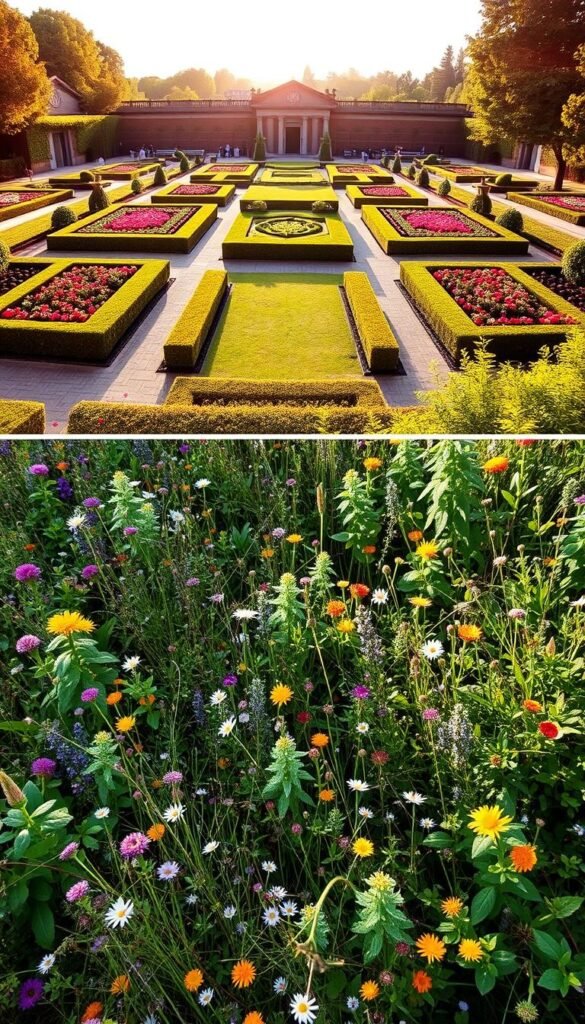Creating your ideal outdoor space starts with understanding two core approaches: meticulously planned layouts and nature-inspired arrangements. Each method offers distinct benefits, whether you prefer crisp geometric patterns or joyful bursts of color that follow nature’s lead.
Structured designs create visual harmony through symmetry and repetition. These spaces often feature precisely trimmed hedges and orderly plantings that demand regular care. On the flip side, free-flowing landscapes embrace organic shapes and self-seeding blooms, supporting local ecosystems while reducing upkeep.
Your choice impacts more than aesthetics. Consider how much time you can devote to maintenance, your local climate, and how the space will interact with your home’s architecture. Smaller yards might thrive with container gardens, while larger properties could incorporate both styles through strategic zoning.
Many gardeners find success blending these concepts. You might pair neatly edged pathways with wildflower meadows, creating balance between human creativity and nature’s spontaneity. This flexibility allows you to craft a unique environment that reflects your personality and supports local wildlife.
As you explore options, remember there’s no universal “right” answer. Your outdoor area should evolve with your lifestyle while considering practical factors like water usage and plant hardiness. The journey to your perfect green sanctuary begins with aligning your vision to the land’s natural potential.
Understanding Garden Styles: Formal vs. Wild
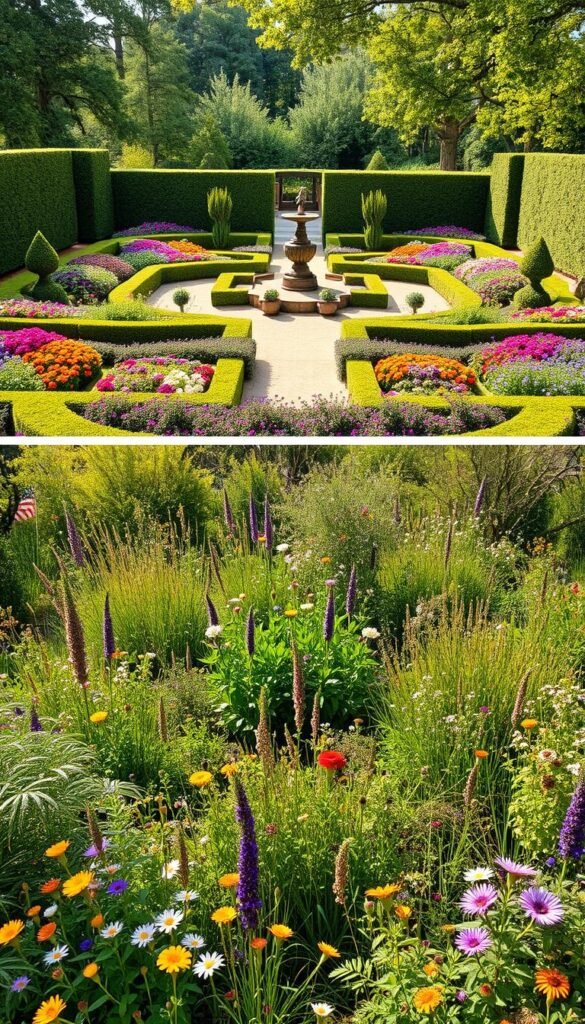
Your outdoor space reflects your personality through design choices. Let’s explore two distinct approaches that shape landscapes worldwide. Each offers unique benefits depending on your priorities and local environment.
Defining a Structured Outdoor Space
Traditional garden layouts prioritize clean lines and geometric precision. Think boxwood hedges shaped into perfect spheres or pathways flanked by identical flowering shrubs. These spaces often feature stone fountains or classical urns as focal points, creating a timeless elegance.
Color schemes lean toward monochromatic greens with white accents. This restrained palette emphasizes form over variety, making these designs ideal for historic homes or modern minimalist architecture. Maintenance is key—weekly trimming keeps every element crisp.
Embracing Natural Landscapes
Wild-inspired spaces celebrate nature’s spontaneity. Native grasses sway beside self-seeding coneflowers, while butterflies dart between milkweed clusters. These ecosystems thrive with minimal intervention, adapting to seasonal changes and local rainfall patterns.
You’ll find fewer straight edges here. Instead, meandering paths reveal surprises like sudden bursts of goldenrod or clusters of berry-bearing shrubs. This approach supports biodiversity while reducing water use—a practical choice for eco-conscious homeowners.
| Feature | Structured Design | Natural Design |
|---|---|---|
| Maintenance | High (weekly trimming) | Low (seasonal care) |
| Plant Selection | Manicured shrubs, hybrid blooms | Native species, drought-resistant plants |
| Wildlife Support | Limited | High (pollinator-friendly) |
Not sure which direction suits your property? Explore garden styles that blend both philosophies for transitional spaces. Many homeowners balance formal entryways with wild backyard meadows, achieving both curb appeal and ecological benefits.
Formal Flower Garden vs. Wild Flower Garden: Which Suits Your Style?
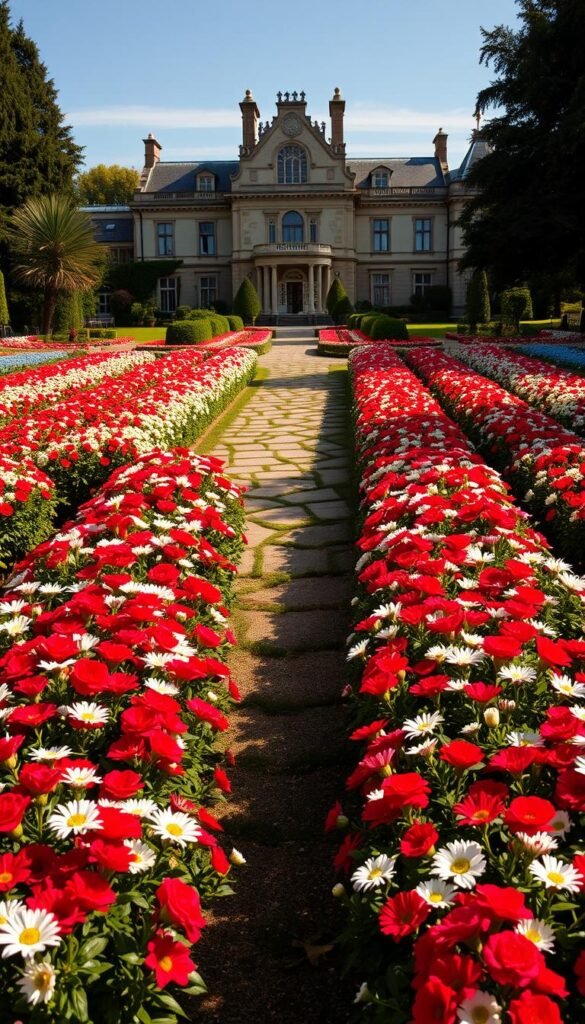
Your outdoor sanctuary should mirror how you live and recharge. One gardener confessed online: “Structured layouts would drive me crazy—I need freedom to rearrange as inspiration strikes.” This raw honesty reveals how deeply our green spaces connect to who we are.
Are you a meticulous planner who thrives on order? Geometric beds with precisely spaced plants might satisfy your need for control. Weekly pruning sessions become meditative rituals rather than chores. But if spreadsheets make you shudder, consider nature-led designs where self-seeding blooms create joyful surprises.
Time availability shapes success. Formal arrangements demand clockwork care—think sculpted hedges needing trims every 10 days. Wild spaces forgive missed weekends, evolving gracefully through seasons. As one forum member noted: “My chaotic patch still buzzes with bees when I’m too busy to weed.”
Budget also guides choices. Manicured landscapes often require:
- Premium paving stones
- Hybrid plant varieties
- Professional landscaping services
Natural designs work smarter, using local species that multiply yearly. You’ll invest sweat equity initially but save long-term. Whether creating a curated showcase or nurturing wildlife habitats, your approach should fuel—not drain—your joy.
Still torn? Many start small—a symmetrical herb garden near the kitchen paired with a wildflower corner. This trial lets you discover what truly makes your heart bloom.
Design Inspirations and Aesthetic Considerations
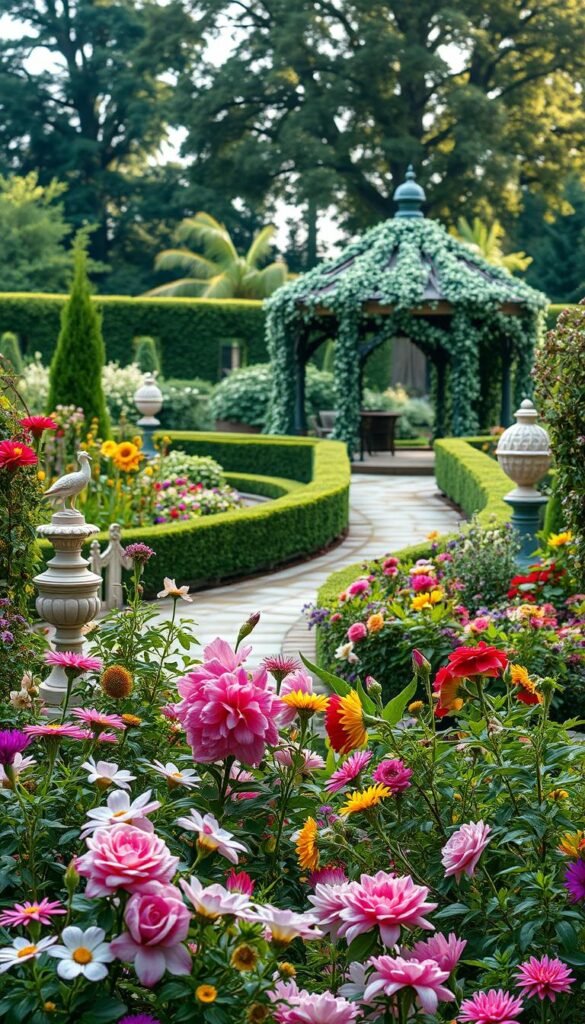
Your landscape becomes art when shapes and hues work together. Whether you crave crisp edges or flowing curves, thoughtful design choices elevate ordinary spaces into living masterpieces.
Mixing Geometric Symmetry with Natural Freedom
Traditional layouts use mirrored plantings along walkways to create instant visual rhythm. Picture tulip beds flanking stone steps or boxwoods framing a courtyard. These patterns guide the eye while establishing order.
Modern approaches play with asymmetry. Imagine interlocking patio stones forming abstract shapes, softened by ornamental grasses. One landscape architect notes: “Clients love combining angular decking with billowing lavender—it’s structured yet relaxed.”
| Element | Traditional Approach | Contemporary Twist |
|---|---|---|
| Lines | Straight, parallel | Curved, intersecting |
| Plant Selection | Uniform hedges | Mixed heights/textures |
| Focal Points | Central fountain | Bold sculpture |
| Materials | Cut stone | Recycled composites |
Choosing the Right Color and Texture Palette
Structured spaces often limit hues to greens and whites for timeless appeal. A single pop of red roses might anchor a seating area. This restraint creates sophistication but demands perfect plant health.
Nature-led designs embrace evolving color stories. Spring might bring purple lupines against yellow coreopsis, while autumn flaunts rust-colored sedum. These combinations shift like sunset hues, offering constant discovery.
Texture adds depth to both styles. Try these contrasts:
- Smooth limestone beside feathery maiden grass
- Glossy holly leaves near fuzzy lamb’s ear
- Rough cedar benches under delicate cherry blossoms
Your materials become part of the palette. Sleek metals suit modern spaces, while weathered wood complements wilder areas. Remember—your style shines when elements feel intentional yet effortless.
Incorporating Cottage and Traditional Garden Elements
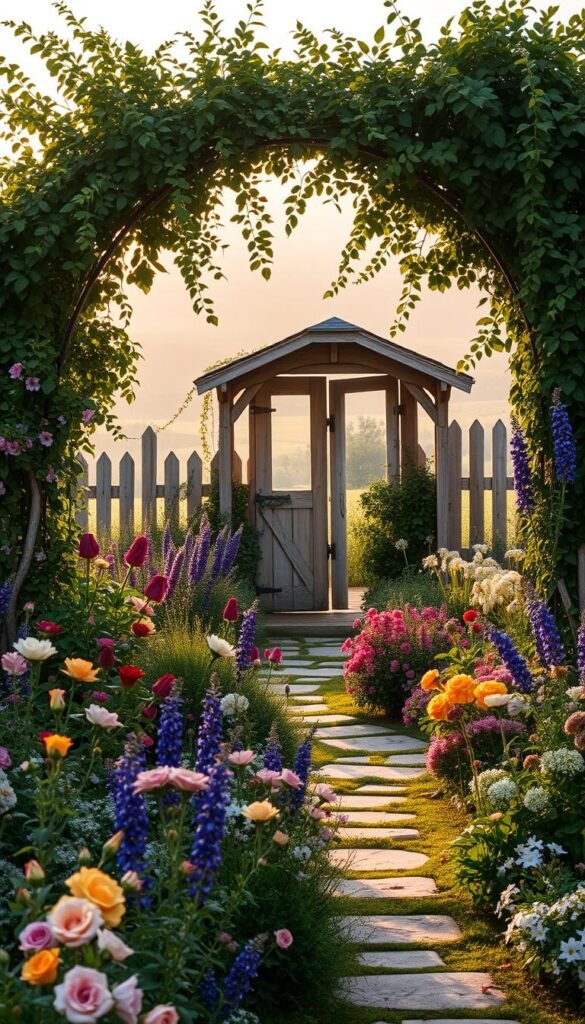
Blend structure and spontaneity through garden design elements that tell your story. This approach bridges meticulous planning with nature’s whimsy, offering both visual harmony and ecological benefits.
The Charm of Cottage Gardens
Cottage gardens master the art of controlled chaos. Beneath their overflowing blooms lies hidden geometry—rectangular beds or circular herb plots frame the space. Plants tumble over paths, merging practicality with beauty as roses mingle with thyme and kale.
These spaces thrive on personality. Weathered benches and climbing clematis on trellises create instant nostalgia. One gardener shares: “My hollyhocks lean into the walkway—it feels like they’re greeting visitors.”
Drawing from Traditional, Structured Designs
Traditional layouts provide the bones for cottage charm. Symmetrical pathways or boxwood borders offer subtle order. You might plant lavender in strict rows, then let calendula spill across edges for soft contrast.
| Feature | Cottage Gardens | Traditional Gardens |
|---|---|---|
| Planting Style | Mixed ornamental/edible | Single-purpose beds |
| Maintenance | Moderate (seasonal pruning) | High (weekly shaping) |
| Materials | Repurposed items | Uniform stone/wood |
Balance is key. Use arbors to define spaces while letting sweet peas climb freely. This fusion creates living landscapes that feel both intentional and joyfully wild.
Practical Tips for Plant Selection and Layout
Smart plant choices transform your outdoor area into a thriving ecosystem. Let’s explore how to match greenery to your environment while creating visual harmony through thoughtful arrangements.
Choosing Plants That Thrive in Your Ecosystem
Start with your soil type and sunlight patterns. Acid-loving hydrangeas won’t flourish in alkaline clay, just as shade plants burn in full sun. Local nurseries often stock species adapted to regional conditions—ask about native alternatives to common ornamentals.
For structured spaces, consider slow-growing evergreens like boxwood. Their predictable shapes maintain clean lines year-round. Natural areas shine with self-sufficient perennials like black-eyed Susans that spread joy without constant care.
| Garden Style | Key Plants | Layout Feature |
|---|---|---|
| Traditional | Yew hedges, hybrid tea roses | Symmetrical rows |
| Modern | Yucca, ornamental grasses | Geometric groupings |
| Natural | Moor grass, New England aster | Drift planting |
Establishing Focal Points and Balanced Layouts
Anchor your design with eye-catching elements. A Japanese maple’s crimson leaves or a stone sculpture can guide viewers through the space. Remember scale—a massive boulder overwhelms small yards, while tiny ornaments disappear in expansive areas.
Layer plants by height for depth. Place tall grasses behind mid-sized coneflowers, with creeping thyme along edges. This approach creates professional-looking beds that evolve beautifully through seasons.
How Landscape Materials Enhance Your Garden
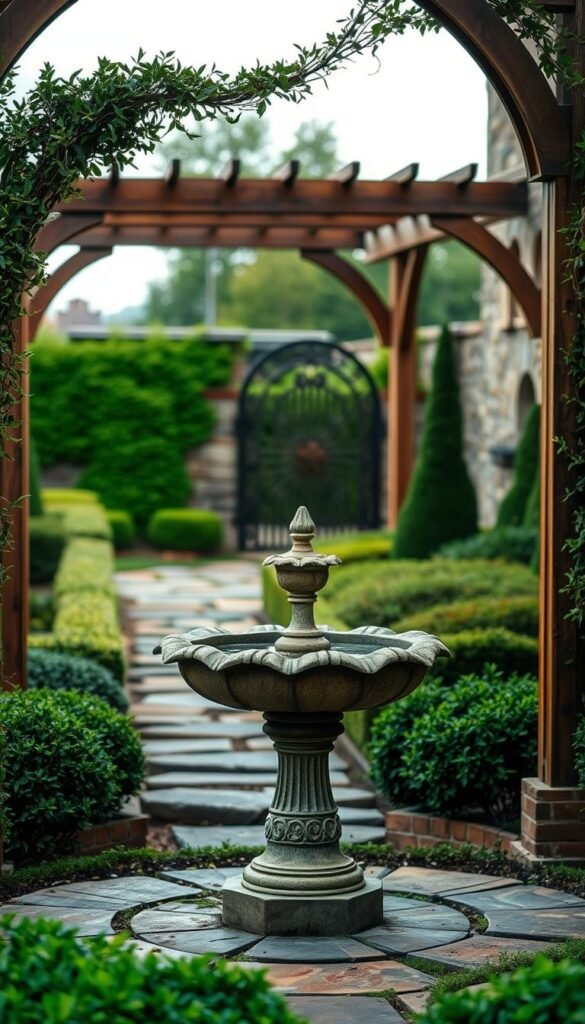
The bones of your outdoor space come alive through strategic material choices. Hardscape elements shape movement patterns and establish visual rhythm while complementing your plants’ natural beauty. Let’s explore how stones, gravel, and metal create functional artistry.
Using Stones, Gravel, and Metal for Structure
Natural stone anchors designs with earthy textures. Flagstone paths guide footsteps through wildflower meadows, while stacked fieldstone walls frame structured herb gardens. River rock edges soften modern spaces, proving versatile across styles.
Gravel solves drainage challenges while adding acoustic charm. The crunch underfoot defines walkways without rigid borders. Pair decomposed granite with sleek metal edging for contemporary flair, or let pea gravel spill informally between cottage blooms.
| Feature | Traditional Approach | Modern Twist |
|---|---|---|
| Path Surfaces | Pea gravel | Geometric concrete |
| Architectural Elements | Stone columns | Galvanized steel |
| Containers | Pedestal urns | Corten planters |
Metal introduces crisp lines that age gracefully. Powder-coated steel retains its sharp edges for modern layouts, while weathered iron blends into rustic settings. One landscaper notes: “Clients love how metal trellises contrast with billowing clematis—industrial meets romantic.”
Installation matters as much as selection. Compact base layers prevent shifting gravel, while proper drainage slopes protect stonework. These techniques ensure your materials stay beautiful through seasons without constant fixes.
Maintenance Strategies for Diverse Garden Types
Keeping your landscape thriving requires tailored care approaches. Whether you prefer crisp geometry or flowing meadows, smart maintenance preserves beauty while respecting each style’s unique needs.
Upkeep Best Practices for Structured Arrangements
Precision is key for manicured spaces. Use sharp shears for weekly hedge trims and deadhead spent blooms to encourage new growth. One landscaper admits: “Clients love the polished look, but it demands military-grade scheduling.”
Seasonal tasks matter most. Spring brings fertilizing and reshaping, while autumn focuses on protective mulching. Invest in quality tools—bypass pruners and edging irons last longer and make cleaner cuts.
| Task | Frequency | Tool |
|---|---|---|
| Hedge Trimming | Every 10 days | Electric Shears |
| Edging | Biweekly | Half-Moon Cutter |
| Soil Testing | Seasonal | pH Meter |
Care Tips for Nature-Led Spaces
Wild areas thrive through strategic neglect. Let native plants self-seed while removing invasive species. A gardener shares: “I only intervene when milkweed threatens to swallow my patio.”
Follow these low-effort steps:
- Mulch annually to suppress weeds
- Divide overgrown perennials every 3 years
- Leave seed heads for winter bird food
Remember—nature does heavy lifting. Your role shifts from controller to observer, adjusting only when ecosystems need balance.
Balancing Structure with Nature in Your Yard
Crafting your perfect yard means blending human creativity with nature’s rhythm. Contemporary designs artfully enhance existing features—think curved seating walls that mirror nearby hills or wooden pergolas draped with climbing roses. These spaces prioritize relaxation, turning patios into outdoor rooms where you’ll host gatherings or unwind after work.
Natural layouts take cues from surrounding ecosystems. A desert yard might showcase agave and yucca, while woodland areas highlight ferns beneath oak trees. These gardens conserve water and reduce upkeep, letting you enjoy beauty without constant effort. By choosing native plant gardens, you’ll support bees and butterflies that rely on regional flora.
Smart balance comes through intentional contrasts. Pair geometric stone planters with billowing ornamental grasses, or frame a wildflower meadow with neatly trimmed boxwood. Your space becomes both sanctuary and habitat—proof that structure and spontaneity can thrive side by side.
Remember: great design works with your land, not against it. Whether adding fire pits for evening chats or preserving existing trees for shade, let your yard reflect how you live while honoring its natural roots.

